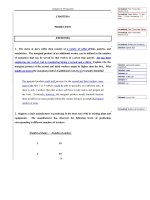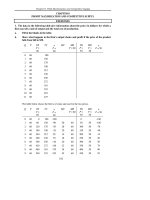Tài liệu Bài tập về Kinh tế vĩ mô bằng tiếng Anh - Chương 1 : Sự dự bị docx
Bạn đang xem bản rút gọn của tài liệu. Xem và tải ngay bản đầy đủ của tài liệu tại đây (58.75 KB, 6 trang )
Chapter 1: Preliminaries
1
PART I
INTRODUCTION:
MARKETS AND PRICES
CHAPTER 1
PRELIMINARIES
Chapter 1: Preliminaries
2
EXERCISES
1. Decide whether each of the following statements is true or false and explain why:
a. Fast food chains like McDonald’s, Burger King, and Wendy’s operate all over the
United States. Therefore the market for fast food is a national market.
This statement is false. People generally buy fast food within their current
location and do not travel large distances across the United States just to buy
a cheaper fast food meal. Given there is little potential for arbitrage
between fast food restaurants that are located some distance from each other,
there are likely to be multiple fast food markets across the country.
b. People generally buy clothing in the city in which they live. Therefore there is a
clothing market in, say, Atlanta that is distinct from the clothing market in Los
Angeles.
This statement is false. Although consumers are unlikely to travel across the
country to buy clothing, suppliers can easily move clothing from one part of
the country to another. Thus, if clothing is more expensive in Atlanta than
Los Angeles, clothing companies could shift supplies to Atlanta, which
would reduce the price in Atlanta. Occasionally, there may be a market for
a specific clothing item in a faraway market that results in a great opportunity
for arbitrage, such as the market for blue jeans in the old Soviet Union.
Chapter 1: Preliminaries
3
c. Some consumers strongly prefer Pepsi and some strongly prefer Coke.
Therefore there is no single market for colas.
This statement is false. Although some people have strong preferences for a
particular brand of cola, the different brands are similar enough that they
constitute one market. There are consumers who do not have strong
preferences for one type of cola, and there are consumers who may have a
preference, but who will also be influenced by price. Given these
possibilities, the price of cola drinks will not tend to differ by very much,
particularly for Coke and Pepsi.
2. The following table shows the average retail price of butter and the Consumer
Price Index from 1980 to 2001.
ˇ
1980 1985 1990 1995 2000 2001
CPI 100 130.58 158.62 184.95 208.98 214.93
Retail Price of butter $1.88 $2.12 $1.99 $1.61 $2.52 $3.30
(salted, grade AA, per
lb.)
Chapter 1: Preliminaries
a. Calculate the real price of butter in 1980 dollars. Has the real price
increased/decreased/stayed the same since 1980?
Real price of butter in year X =
CPI
1980
CPI
year X
*nominal price in year X
.
1980 1985 1990 1995 2000 2001
$1.88 $1.62 $1.25 $0.87 $1.21 $1.54
Since 1980 the real price of butter has decreased.
b. What is the percentage change in the real price (1980 dollars) from 1980 to 2001?
Percentage change in real price from 1980 to 2001 =
1.54 − 1.88
1.88
=−0.18 =−18%
.
c. Convert the CPI into 1990 = 100 and determine the real price of butter in 1990
dollars.
To convert the CPI into 1990=100, divide the CPI for each year by the CPI
for 1990. Use the formula from part (a) and the new CPI numbers below to
find the real price of milk.
4
Chapter 1: Preliminaries
New CPI 1980 63.1 Real price of milk 1980 $2.98
1985 82.3 1985 $2.58
1990 100 1990 $1.99
1995 116.6 1995 $1.38
2000 131.8 2000 $1.91
2001 135.6 2001 $2.43
d. What is the percentage change in the real price (1990 dollars) from 1980 to 2001?
Compare this with your answer in (b). What do you notice? Explain.
Percentage change in real price from 1980 to 2001 =
−2.43 2.98
=− =−0.18 18%
2.98
. This answer is almost identical (except for
rounding error) to the answer received for part b. It does not matter which
year is chosen as the base year.
3. At the time this book went to print, the minimum wage was $5.15. To find the
current minimum wage, go to
/> Click on: Consumer Price Index- All Urban Consumers (Current Series)
Select: U.S. All items
5









